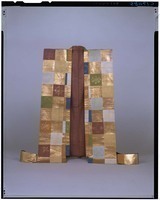Sobatsugi
そばつぎ 側次
A sobatsugi is a broad-sleeved (ōsode 大袖) long vest-like noh costume, essentially a sleeveless lined happi 法被 that is patterned in metallic and colored thread and worn by male and female Chinese characters over a kosode robe or bound at the waist to simulate a warrior's armor. Also known as sodenashi, or "sleeveless".
Noh Kyogen
Roles and Draping
This costume is used for roles of women from China (Kureha 呉服). The sobatsugi is draped so it hangs straight over a kosode. For roles of fierce deities (Kinsatsu 金札) and warriors (Soga brothers in Youchi Soga 夜討曽我), the sobatsugi is worn over hangiri 半切 or ōkuchi 大口 and belted at the waist. As such it substitutes for a happi with hiked up sleeves, providing easier mobility. Kyōgen roles of low-ranking Chinese officials wear a sobatsugi over ankle-bound momohiki trousers.
Textile Features and Tailoring
The knee-length sobatsugi has a narrow, straight collar that runs almost down to the hem and cloth bands joining the front and back panels at the hem and is always lined. Like happi, sobatsugi have designs rendered in colored thread and/or gold and silver thread on a solid ground, which may be satin, twill, or possibly plain weave. A few have embroidered designs.
Designs and Colors
Many of the designs have a Chinese flavor, like dragons among clouds, or classic geometric forms. When used to imitate armor, sobatsugi with bold patterns in gold against a navy, green, brown, or white background are favored. For Chinese roles, the designs tend to be denser, possibly smaller, and include multi-colored threads.

Sobatsugi with cobblestone squares and various treasures on a gold ground. 18th century. Tokyo National Museum
http://webarchives.tnm.jp/imgsearch/show/C0019085
Contributor
Monica Bethe